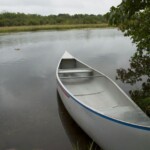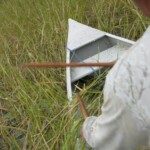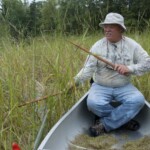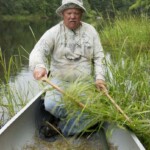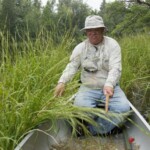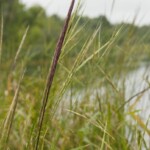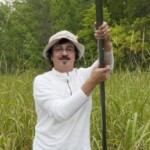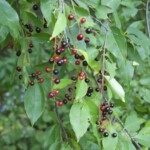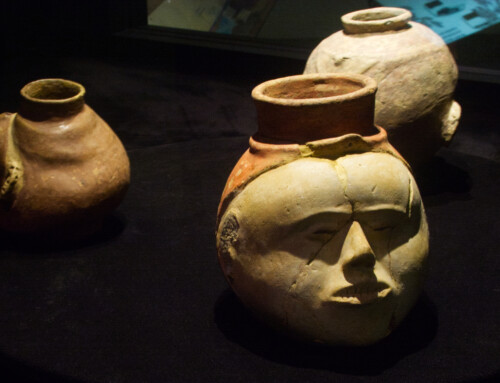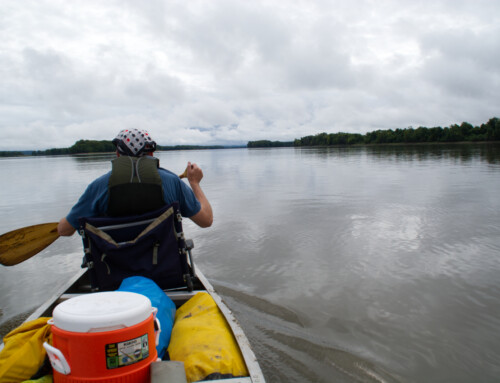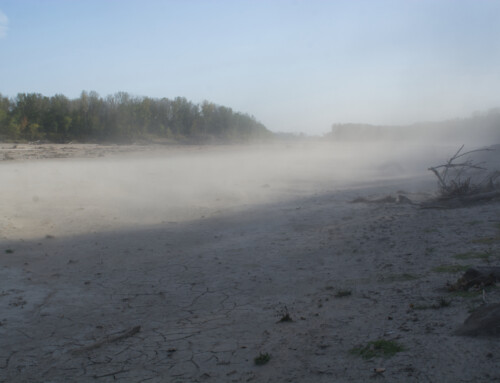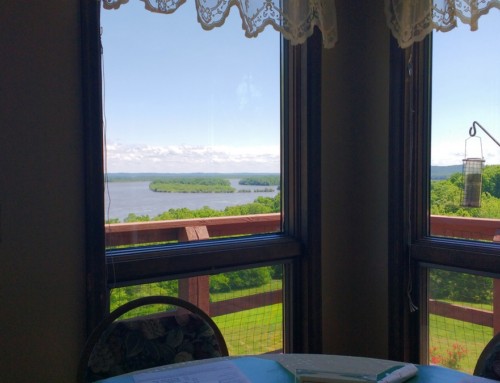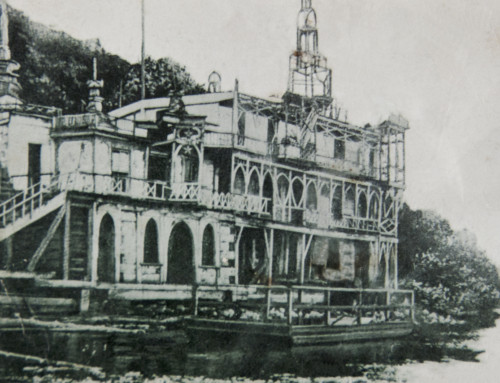It’s the last day of August, but it feels more like October. The sky is a monotonous grey, and the air has barely warmed above 65° F (18° C); with the light breeze and intermittent mist, I’m wishing I had a sweater. In spite of the clouds and moisture, I’m about to get in a canoe and try my hand at harvesting wild rice. My mentor for this is Terry Larson, guide extraordinaire of the Mississippi Headwaters region and a lifelong resident of the area.
For Native Americans who lived in the Upper Midwest, wild rice is central to their diet and culture, maybe less defining than language but much more than just something to eat. When the Ojibwe migrated from the east coast to the upper Midwest, a prophecy foretold that they would know they had reached their new home when they found the land where food grows on water. The prophecy wasn’t referring to a hydroponic greenhouse but to wild rice.
Wild rice—manomin in Ojibwe and psin to the Dakota—is not actually rice but an annual grass (Zizania aquatica). Early French explorers called it Folle Avoine or “False Oat.” It sprouts from seeds after the water has warmed above 45°F, preferring the shallows of lakes and rivers. Ribbon-like leaves shoot to the surface by June and will grow about two feet above the water, forming thick patches that resemble a wheat field. The kernels ripen from late August into early September, some 110 days after germination. The best beds are often found in places where the water has some movement, either from wind or a slow current.
The ripening of wild rice portends the end of the brief northern summer and the need to prepare for the long winter. To the Ojibwe, August is Manoominikie-giizis, or the Wild Rice Moon. It is the month that the Ojibwe and Dakota moved to areas with abundant wild rice beds where they harvested and processed the rice. Favorite locations include places known today as Red Lake, Big Sandy Lake, and Mille Lacs Lake. Wild rice is the food safety net; it is high in protein and carbohydrates and, as long as it is kept dry, it will keep indefinitely. In the middle of winter, if all other food sources are scarce, at least there is rice.
As we pull into the parking lot, Terry catches sight of a bush full of ripe black currants and tells me we will stop there after we are finished ricing. As we get out of the truck, Terry is hobbling; in a few weeks he will undergo hip surgery. Every move takes great effort and the pain is unrelenting, but it doesn’t stop him from getting outside to rice and pick berries.
Before we lift the canoe off the truck, Terry asks me to lift my shirt. “Maybe he wants to rub my (growing) beer belly for good luck,” I think to myself. “It could be part of the ritual.” When I comply, he places a piece of duct tape over my belly button. “That’s not what I expected.” This precaution is apparently necessary because the rice kernels have barbs that can easily embed themselves in a bellybutton, which can lead to a very nasty infection. Those same barbs are the reason I’m not supposed to rub my eyes or pick my nose if anything gets in them.
With the canoe in the water, I gingerly step in (stepping gingerly is not generally among my strengths), and we push off. We are on the Mississippi River some ten miles east of Bemidji, a quiet stretch of the river where the water is barely more than hip deep. Paddling is easy; even going upstream, the current poses little resistance. After a few minutes we reach the first patch of rice. Before we start harvesting, we pause to offer a traditional blessing and scatter dried sage to the winds.
Harvesting wild rice efficiently takes the effort of two skilled people: one to keep the canoe moving, usually with a long pole that is used to gently propel the boat forward, and another who removes the ripe kernels via a technique called knocking. I’m the poler. As we crawl through the rice patch and leave a little clearing in our wake, Terry offers me instruction.
“You’re watching these paths you have made before and you’re trying to stay over four to six feet to where I have room to knock. You’ll get it.”
It’s my job to keep the boat moving in a steady pace and in a straight line, something that I quickly learn takes skill that I’m not getting. As soon as I complete a push and lift the pole to place it anew and push again, the canoe stops. Every time. Maybe because I’m so focused on trying to maintain forward momentum, the canoe is zigzagging through the rice patch; Terry occasionally pulls out a paddle to help correct our course. I’d like to say I got better with practice, but I really didn’t, except that maybe we zigged and zagged a little less between our stops and starts.
Terry is more practiced at rice harvesting, so his knocking technique is far superior to my poling skills. The most essential equipment for a knocker is a pair of wooden sticks called flails that are about 18 inches long, wide at the end where it is gripped and tapered to a point at the other end. Terry uses a well-worn pair that he found on nearby Star Island, apparently abandoned or forgotten by its previous owner.
As we wend our way through the thicket, Terry bends the stalks down into the canoe with one flail and gently taps the top of the stalks with the other to release the kernels.
“The main thing is you want to lay that rice over, and you want a nice 45° angle to hit behind the head. I’m the type who likes to hit one side once or twice, and the other side once or twice. Everyone has different patterns of their knocking. For me it’s just finding that rhythm.”
Some kernels will inevitably miss the canoe and fall into the water, which is fine; it provides the seeds for next year’s rice. Unripened kernels remain attached to the stalks, so fields can be harvested a second time a few days later after the remaining kernels have ripened.
Even though much of our equipment is made of modern materials—aluminum for both the canoe and the pole—the knock of the flail is an ancient technique, one executed for dozens of generations before us, harvesting wild rice in the same manner for hundreds, perhaps thousands of years.
One thing that hasn’t changed much is the amount of edible rice one gets from the raw product.
TL: “I’m hoping, Dean, for a 40 or 45% finish. So if I buy a thousand pounds from them gentlemen {the ones harvesting the rice} green, I’m hoping I have 400 to 450 pounds {of edible rice}.”
Back on land, Terry headed right to the black currants, and we spent the next few minutes picking the bush clean. I sample a few; the ripe fruit reminds me of a cherry but with a slightly bitter aftertaste. Considering how short the growing season typically is in northern Minnesota, the forest is surprisingly abundant: blueberries, chokecherries, raspberries, black and red currants, cattail tubers (starchy and potato-like), wild game like waterfowl, deer, and grouse, wild rice, hazelnuts, mushrooms, fish, and Labrador tea, to name a few.
Our rice and currant harvesting finished, we head back to the truck. Terry gives me a jar of high bush cranberry jam he personally prepared, as well as instructions on how to process the wild rice we harvested today. As we leave, it’s still cloudy but the mist has stopped. I still have duct tape on my belly, but no barbed kernals in my eyes or nostrils.
The bag Terry handed me has about two pounds of raw wild rice (and maybe another pound of insects); a paltry harvest I suppose, but enough to satisfy this first-timer. Terry has also given me instructions on how to process the wild rice by hand, which I vow to do as soon as I get back to St. Louis in a few days.
- Reach and push, reach and push
- The ricing canoe
- Gliding through a rice patch
- Terry showing off his knocking skills
- Ripe kernels fall off easily
- Making a path through the patch
- Bend the stalks with one flail and tap with the other
- Terry has done this before
- Wild rice (Zizania aquatica), aka manomin or psin
- Getting ready to push
- Black currants
© Dean Klinkenberg, 2011
**Read more about the places in northern Minnesota in Road Tripping Along the Great River Road, Vol. 1 and the Headwaters Region Guide. Click the links above for more. Disclosure: This website may be compensated for linking to other sites or for sales of products we link to.
Community-supported writing
If you like the content at the Mississippi Valley Traveler, please consider showing your support by making a one-time contribution or by subscribing through Patreon. Book sales don’t fully cover my costs, and I don’t have deep corporate pockets bankrolling my work. I’m a freelance writer bringing you stories about life along the Mississippi River. I need your help to keep this going. Every dollar you contribute makes it possible for me to continue sharing stories about America’s Greatest River!

